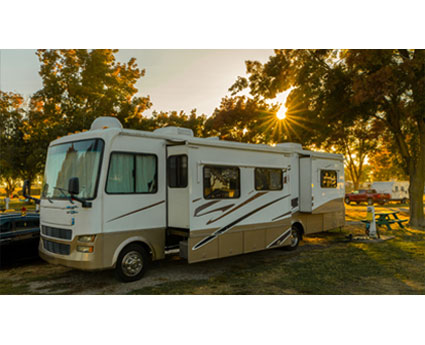Portable Power Stations vs. Generators for RV Boondocking
If you’re an experienced RVer, you already know that boondocking is equal parts freedom and strategy. You’ve probably figured out your solar setup, how to conserve water, and maybe even how to squeeze a few more amps out of your batteries. But when it comes to powering your air conditioner or heavier appliances, one big question always comes up: Should you rely on a portable power station or a generator?
We talk to RVers every week who are trying to find that balance between comfort and conservation. Some want peace and quiet. Others just want to keep their pets cool without draining the batteries. And while both options can work beautifully off-grid, they serve different lifestyles.
In this guide, we’ll break down:
- The key differences between portable power stations and generators
- Pros and cons of each for boondocking
- What each can realistically power (and for how long)
- How a soft starter like Micro-Air’s EasyStart™ Breeze can make either setup more efficient
What’s the Difference Between Portable Power Stations and Generators for RVs?
Portable power stations and generators both provide electricity, but in very different ways.
Portable power stations are battery-based units that store energy and deliver silent, emission-free power. They’re rechargeable through solar panels, wall outlets, or even your RV’s alternator.
Generators, on the other hand, create power on demand by burning fuel, usually gasoline, propane, or diesel. They’re strong, steady, and ideal for high-draw appliances like air conditioners or microwaves. But, they’re also louder and dependent on a steady fuel supply.
Both can keep you comfortable while boondocking. It really just depends on how you like to camp, how much power you need, and how much noise you’re willing to tolerate.
How Do Portable Power Stations Work?
A portable power station acts like a giant rechargeable battery. Most modern models use lithium-ion or LiFePO4 cells, known for their long lifespan and high energy density.
You can charge them several ways:
- From solar panels during the day
- From shore power or an AC outlet before your trip
- From your vehicle’s alternator while driving
Because they don’t produce emissions, they’re safe for indoor use and can run quietly through the night. These are perfect for campers who prefer the sound of crickets to the hum of a generator.
What Types of Electronics Do Portable Power Stations Power?
Portable power stations can handle:
- LED lights and ceiling fans
- Laptops, tablets, and phones
- CPAP machines
- Small kitchen appliances (coffee makers, mini-fridges, blenders)
However, most can’t handle RV air conditioners unless they have significant capacity, typically 2,000–3,000Wh minimum. And, you need an inverter powerful enough to manage startup surges.
Even top-tier models may struggle with the surge current from an AC compressor. That’s where an RV AC soft starter comes in handy, reducing the startup load so your air conditioner can run more efficiently.
Pros of Portable Power Stations for RV Boondocking
- Silent and emission-free operation
- Solar-rechargeable and eco-friendly
- No fuel required, minimal maintenance
- Compact and easy to store
Cons of Portable Power Stations for RV Boondocking
- Limited capacity for high-draw appliances
- Slower recharge times
- Higher cost per watt compared to generators
- Batteries degrade over time
How Do Generators Work?
Generators convert fuel into electricity using an internal combustion engine. They produce continuous AC power that can run nearly every RV appliance without draining your onboard batteries. From the air conditioner to your coffee pot, you’ll be covered.
Inverter generators are particularly popular among RVers. They provide cleaner, quieter power that’s safe for sensitive electronics. Your laptops and TVs will be safe, making this option the top choice for off-grid camping.
What Types of Electronics Can Generators Power?
- RV air conditioners (especially with a soft starter)
- Microwaves, coffee makers, and refrigerators
- Battery chargers and electronics
The ability to power your AC off-grid is often the deciding factor for most boondockers. This is especially true for those traveling with pets or through hot climates.
Pros of Generators for Off-Grid Camping
- Powerful enough for large loads
- Long runtime when refueled
- Versatile fuel options (gas, propane, diesel)
- Reliable and widely available
Related: What Size Generator Do You Need to Run an RV Air Conditioner?
Cons of Generators for Off-Grid Camping
- Noise and exhaust emissions
- Requires fuel storage and maintenance
- Heavier and bulkier than power stations
- Sometimes restricted in quiet campgrounds
How a Soft Starter Improves Performance for Generators and Power Stations
Here’s where the conversation shifts from either/or to and.
A soft starter like the Micro-Air EasyStart™ Breeze reduces the power surge when your AC compressor kicks on, by up to 75%. That means smaller, quieter generators (as low as 2,000 watts) can handle loads that would normally trip breakers or overload circuits.
For example:
A 13,500 BTU air conditioner typically needs around 3,500 watts to start. With a soft starter installed, it can start comfortably on a 2,000-watt generator.
For generator users, that means less noise and less fuel burned. For power station users, it means your system can handle brief AC use in hybrid setups, combining solar, battery, and generator power.
It’s one of the simplest upgrades RVers can make to stretch their off-grid capabilities.
Portable Power Station vs. Generator — Side by Side Comparison
|
Factor |
Portable Power Station |
Generator |
|
Power Output |
Moderate |
High |
|
Noise |
Silent |
Audible (varies) |
|
Maintenance |
Minimal |
Regular |
|
Eco-Friendliness |
Excellent |
Moderate |
|
Cost per Watt |
High |
Lower |
|
AC Compatibility |
Limited (without soft starter) |
Excellent (with or without soft starter) |
Most seasoned boondockers eventually use a combination of both. A generator for heavy loads and a power station for quiet nighttime use seems to be the sweet spot.
See also: RV Boondocking: Best Ways to Power Your RV
Choosing the Right RV Power Source for Boondocking — Our Thoughts
Both portable power stations and generators can make off-grid camping more comfortable. The right choice depends on how you travel.
If you prioritize silence and sustainability, a power station paired with solar panels is a great setup for light energy needs. If you need air conditioning in the desert or plan to camp for extended periods, a generator remains the most reliable solution.
Either way, adding a Micro-Air EasyStart™ Breeze Soft Starter takes your setup to the next level.
- Manufactured, tested, and supported in the USA
- Reduces AC startup surge by up to 75%
- Compatible with all major RV AC brands
- Trusted by full-time RVers, DIY enthusiasts, and weekend travelers alike
- Available Bluetooth technology lets you monitor performance, troubleshoot safely, update firmware, and transfer devices remotely
Learn how the EasyStart Breeze RV soft starter can help your RV system run smoother on smaller power sources.
Helpful Links:
Related Reading:
- Can You Run an AC with Solar Power in an RV?
- How Many Amps Does an RV AC Draw?
- 10 Easy Ways to Make Your RV More Energy Efficient
FAQs About Powering Your RV Off-Grid
Here are some of the most common questions we hear from our RV community as they plan their next adventure.
Can a Portable Power Station Run an RV Air Conditioner?
Usually not, but with a soft starter, larger-capacity power stations can handle short AC runs. The EasyStart™ Breeze is specifically designed to reduce that power spike so you can stay cool even when off-grid.
Can You Combine a Generator and a Portable Power Station?
Absolutely. Many RVers use a generator to recharge their power station during the day, then rely on battery power at night for silent operation. It’s a great way to extend your stay without running the generator nonstop.
How Much Power Do I Need for Boondocking?
Every setup is different, but most RVers use between 2–4 kWh per day for essentials. Track your consumption with a simple power meter to size your system properly.
Note: This article is for informational purposes only; Micro-Air does not make recommendations or provide support outside of Micro-Air products.





